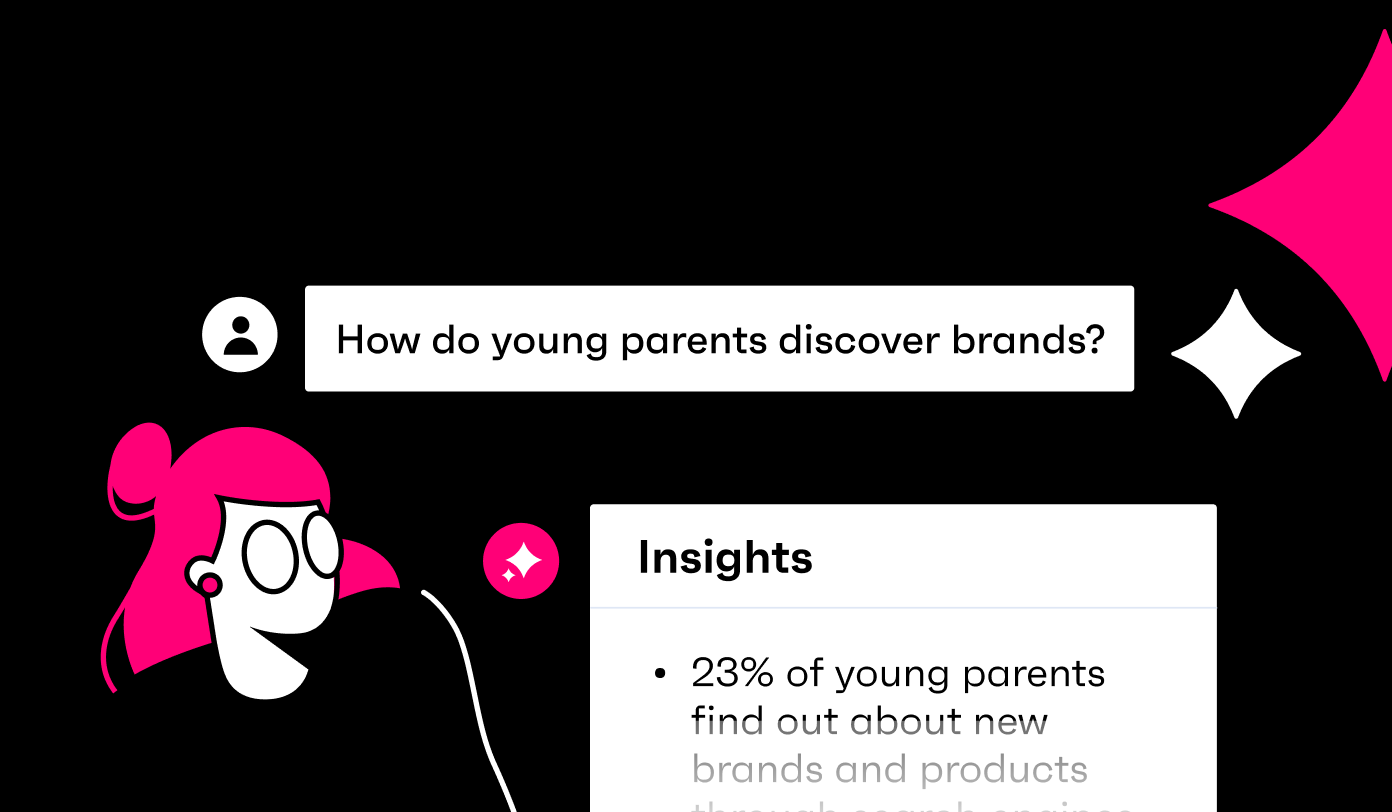There’s a lot of debate about what it takes to create scroll-stopping ads and award-winning campaigns, but here’s one truth we’ll always stand by:
Market research is the backbone of every successful strategy.
When you know how to do market research, you have the power to understand consumers and make data-led decisions with confidence. Without the right data to light the way, you’re just aiming for your target audience in the dark. But let’s back up.
The key to conducting market research is not only having the right market research tools to do the heavy lifting for you, but understanding what it is, why you need it, and how you can use it to take your business to the next level.
What is market research?
Market research is the organized gathering of information about target markets and consumers’ needs and preferences. It’s an important component of business strategy and a major factor in maintaining competitiveness.
How could your business benefit from conducting market research?
Not sure if market research is something you need? Think of it like a compass. It’s what guides you through the maze of consumer behavior, so you can drive growth, maximize ROI, and sharpen your competitive edge. It doesn’t matter if you’re a small business just getting on its feet or a successful brand trying to step up its game, really getting to grips with who it is you should be targeting is always a good idea.
You can use market research to improve your products, services, and messaging to make sure you’re always ahead of the curve.
It’s not just about understanding the here and now. It’s your crystal ball to help you spot big trends, fresh opportunities, and areas for innovation before it’s too late.
Types of market research
Market research isn’t a one-size-fits-all solution. There are different ways to gather insights, each with their own strengths. Let’s dive into the main types of market research.
Primary market research
This method uses surveys, interviews, or focus groups to gather first-party data and insights directly from the source – your target audience. It’s also known as field research, as it involves conducting and analyzing the data yourself. This type of traditional market research is usually quite expensive and super time-consuming.
Secondary market research
Unlike primary research, secondary research uses existing third-party data collected by others like reports, studies, and stats that are available to the public.
Qualitative research
Qualitative research explores the why behind consumer behaviors through open-ended questions. This is a great option when you’re looking for answers about experiences and feelings, rather than just a simple yes or no answer or numerical data. Qualitative questions help you learn more about people’s experiences and perspectives, so rather than asking “Do you use social media?”, you’d ask “What are your favorite social media platforms?” and “What are your reasons for using them?” instead.
Quantitative research
Quantitative research uses statistical data to zero in on patterns and trends through closed-ended questions. Questions can be yes or no like “Do you shop at discount stores?” or questions with a numerical answer like “How many times have you used our new product in the last month?”
Consumer research
This type of research delves into the lifestyles and behaviors of your target audience to give you a deeper understanding of who they really are. By using both qualitative and quantitative methods, you get the full picture of what they like, what they do, and what they want from brands, so you can personalize your marketing strategies.
Brand research
Brand research is your key to gauging brand awareness, loyalty, and overall brand health through the eyes of consumers. It involves collecting and analyzing data on brand performance, perception, and positioning in the market.
Product research
This type of research gives you insights into product demand, features, and pricing. It involves gathering and analyzing information about your product’s market potential, performance, and user experience before launching.
Where to start when choosing your market research platform
Choosing the right market research platform is critical if you want to get a deeper understanding of the consumers, competitors, and markets you want to target. These are some things to consider before you take the plunge:
Define your research needs
Having crystal clear goals about what you want to get out of your market research and how your chosen platform can help you reach them is essential. Make sure you’ll have access to the data coverage you need, will be able to get the right level of detail, and get the research back in the right time frame. This is what will guide all of your efforts.
Target audiences
Do you know who you want to connect with? Knowing your target audience is a non-negotiable if you want to ensure your messaging aligns with their preferences and behaviors. The right platform will have lots of info on your target audience, make it super easy to get the insights you need, and help you identify new markets in a flash. Bonus points if you can build customizable audiences like you can with us.
Research methodology
Picking the right research methods – whether that’s surveys, focus groups, or bespoke reports – will help you get the most relevant insights for your business. Pay special attention to how the research is collected, how reliable it is, and how often new waves are released.
Ease of use
There are lots of market research companies to choose from, but it’s important to pick a research tool that not only suits your needs, but offers actionable insights – and fast. The best platforms give users of all levels the power to self-serve insights so you don’t have to be an expert to grab the data and go.
How to conduct market research with GWI
Our global, on-demand platform is accessible to everyone – not just data experts. Even if you don’t know how to do market research, you can still get to those valuable insights that make a difference. But you need a game plan to make sure you get exactly what you need. Here’s a blueprint you can follow if you’re not sure what steps to take.
1. Identify challenges and define key goals
Start by pinpointing specific challenges you want to improve – whether that’s combatting low sales, improving poor ad performance, or launching a new product. Some of the biggest brands use GWI to grow their audience, enter new markets, create products consumers will love, and outshine the competition.
Next, hone in on what success looks like for you by setting specific, measurable goals with a definitive time frame. This will help you get a clear picture of how the platform can help you and where you should focus your efforts. Here are some of the key uses we can help with:
- Media planning
- Content marketing
- Brand strategy
- Product development
- Partner and sponsorship opportunities
- Pitching
- Market sizing
2. Develop your research strategy
Dive into the platform and start building your audience by picking the data set you want to use. With our flagship data set, you can explore 250,000 profiling points across 50+ markets to apply to your audience, covering key areas like demographics, lifestyle habits, and purchase behaviors. Want to dive even deeper? Add more data sets to hone in on your perfect audience.
After saving your audience, you can apply it to different question charts to help you uncover new things about your audience, and point you in the right direction for the next step.
3. Collect and analyze data
Once you have the data you need, you can collate and export it into a shareable dashboard to get a bird’s-eye view of who you’re targeting before digging even deeper. This is where you can spot key insights you need for your strategy. Look for patterns, compare and contrast audiences, and even track trends over time.
Short on time? Take advantage of our built-in AI features that allow you to create charts on the fly with instant charts, and quickly generate top data points using instant audience insights.
And for an even deeper view, you can use our API to blend our data with your own, allowing you to get even more granular in your research.
4. Plug insights into your strategy
Once you have the data you need to refine your targeting, optimize messaging, and stand out from the competition, you can start building the perfect strategic plan. You’ll know exactly who you’re talking to, what they want to see, and how you can deliver.
GWI’s audience activation lets you push look-a-like audiences based on GWI data directly into whatever platform you’re activating your digital campaign in, including Meta, Google, TikTok, LiveRamp, The Trade Desk, and many more.
Now’s your time to shine with insights that help you turn a hunch into your next big idea. You’re ready to create world-class campaigns, ads, or products that resonate with your audience, and make decisions with confidence.
Need some inspo? Here are some examples of what data-driven success looks like with GWI.
Looking for more specific insights?
With GWI Custom, we offer bespoke recontact surveys, analytics, and solutions to meet your unique needs. Our experts take care of the details from decks and infographics to white papers and custom dashboards. Whether you want an in-depth exploration of industry-specific insights or just want even deeper data on your target audience, we can help.
Fancy a look around?
Book your demo





.webp?width=495&height=317&name=pink_thumb_graphs%20(1).webp)
.webp?width=495&height=317&name=pink_thumb_letter%20(2).webp)
